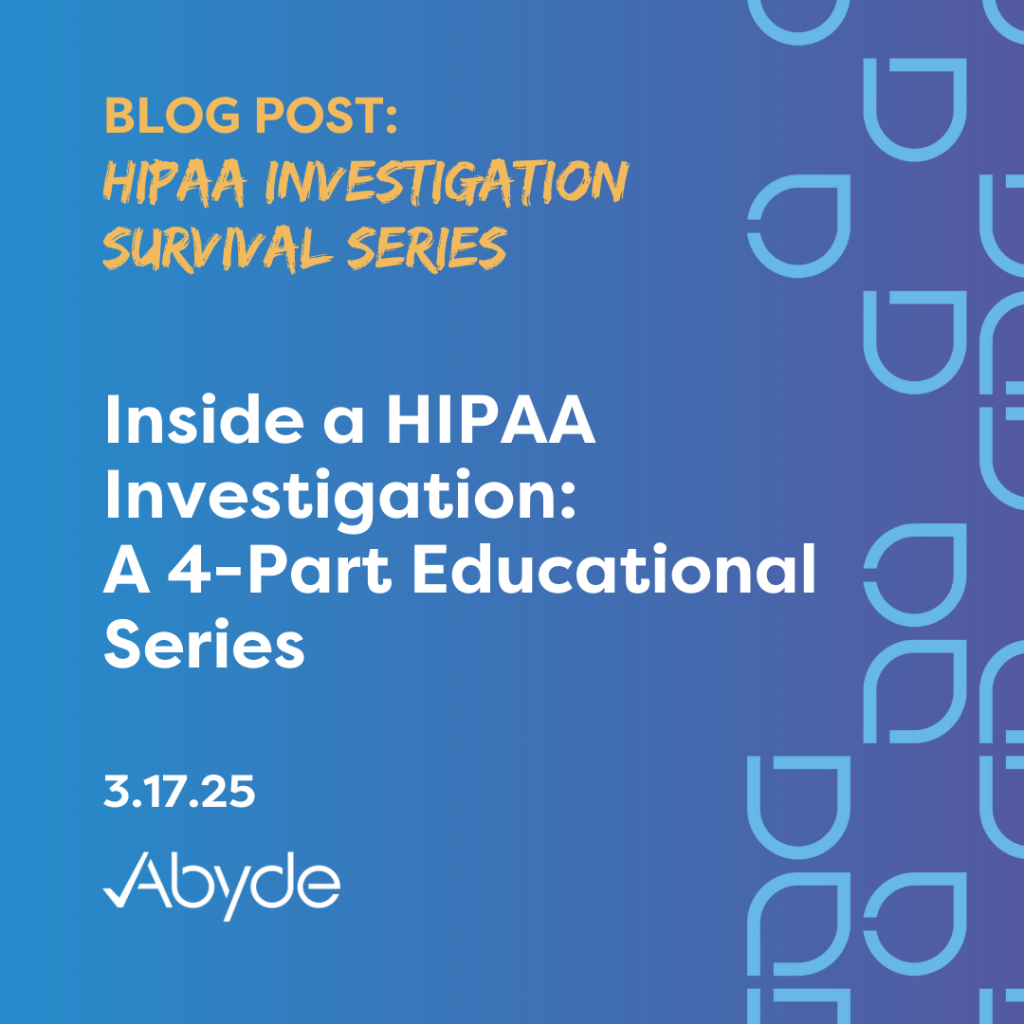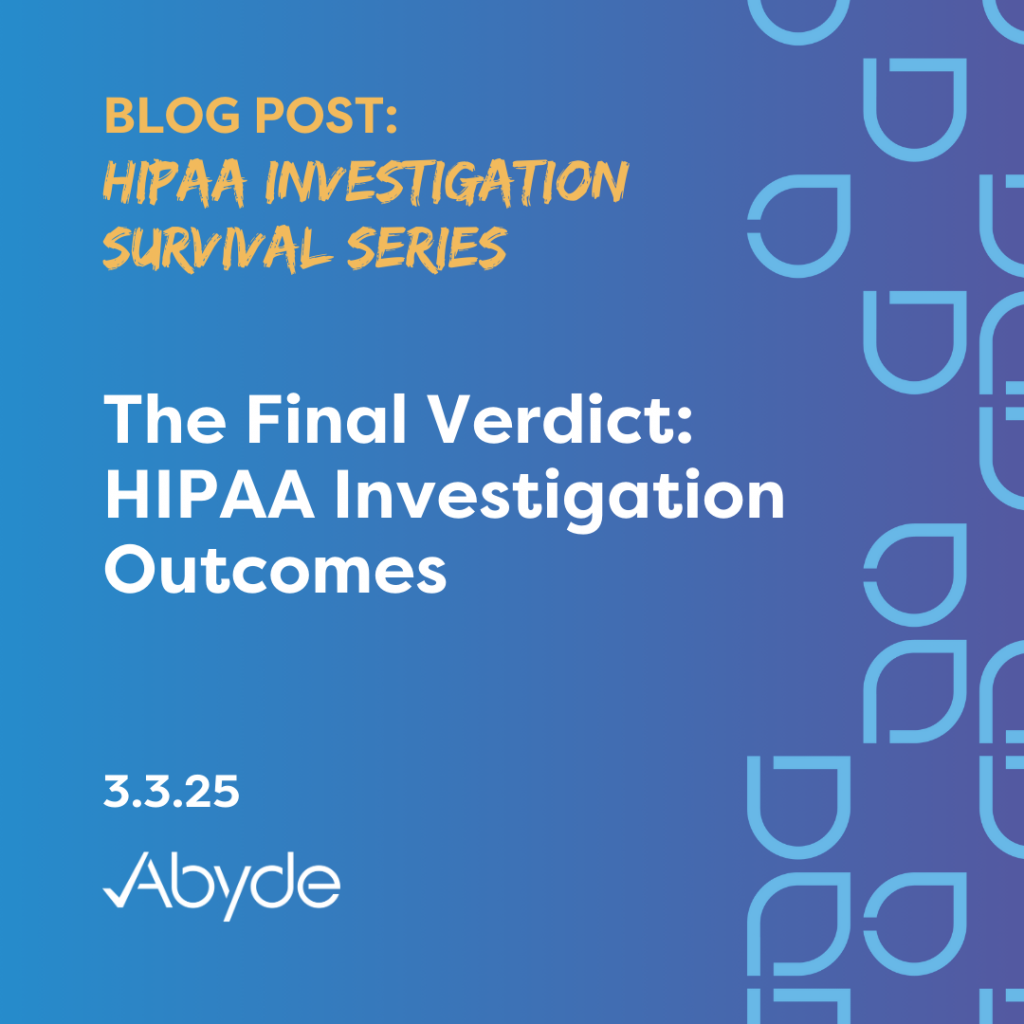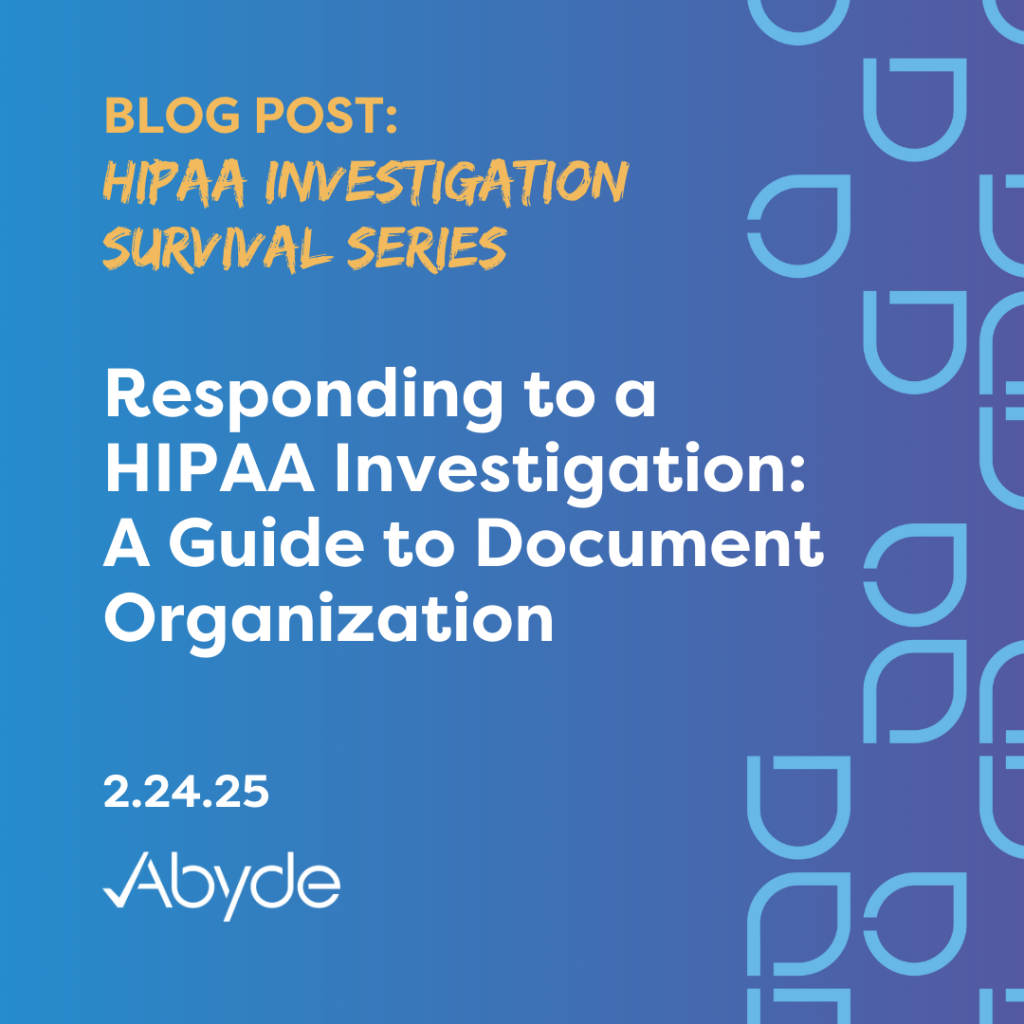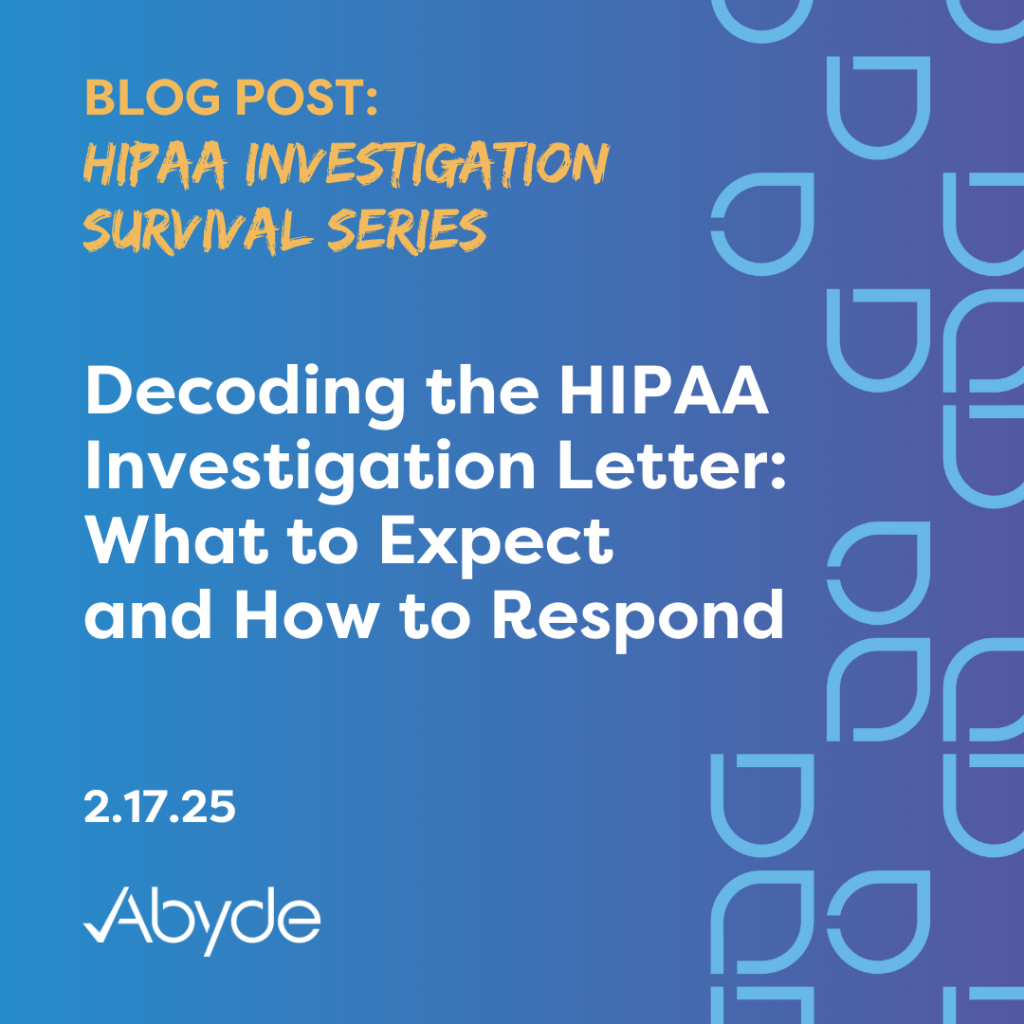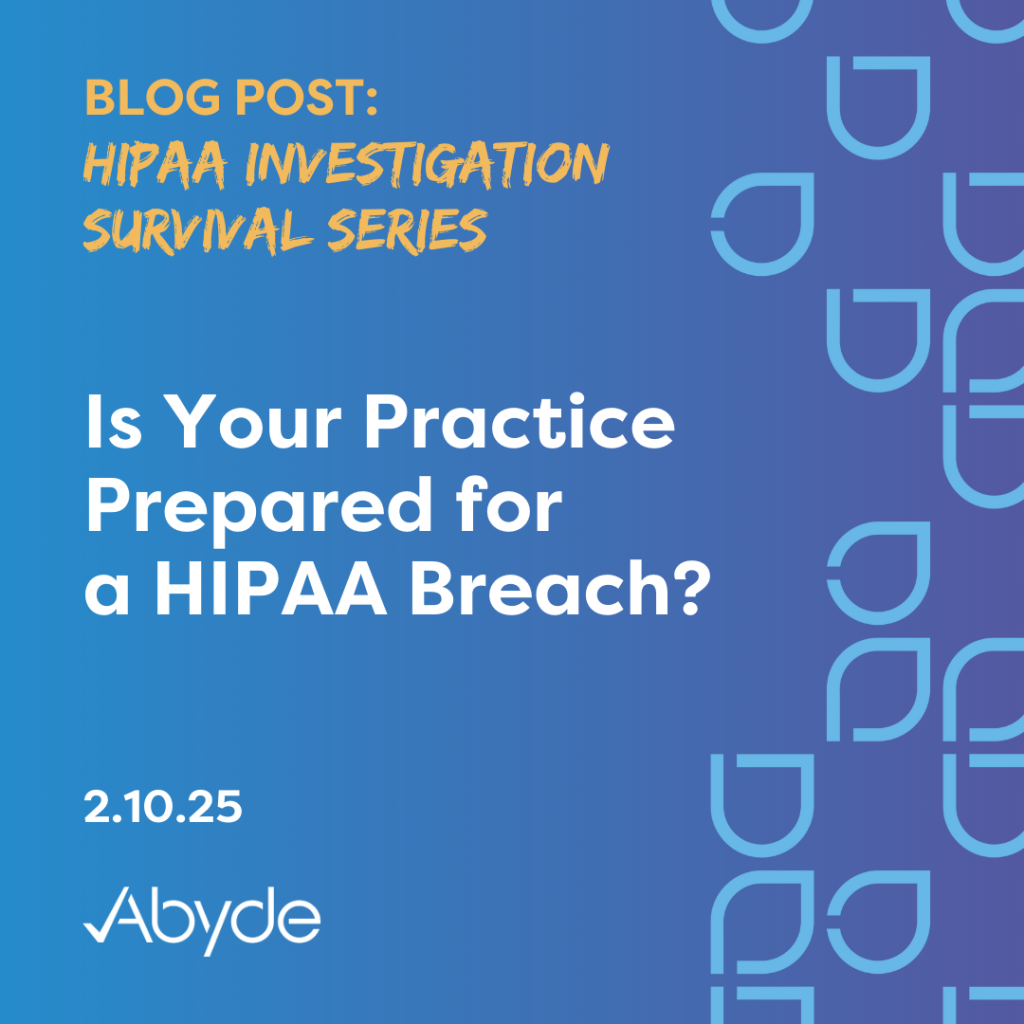March 17, 2025 Getting a HIPAA investigation letter can be overwhelming, but your practice can successfully navigate the process with the right resources. This series is designed to be your easy-to-read guide, walking you through each step of the process. We’ll break down everything from understanding the initial letter to navigating potential outcomes, providing you with best practices to keep your practice confident and prepared if you ever receive a letter. Blog 1: Is Your Practice Prepared for a HIPAA Breach? A common misconception is that a HIPAA breach causes your practice to be fined. Instead, your practice’s lack of proactive measures and proper response to a breach is what leads to disciplinary action. Although it’s impossible to prevent breaches completely, the proper safeguards can minimize their risk and impact. Learn more about breach mitigation here. Blog 2: Decoding the HIPAA Investigation Letter: What to Expect and How to Respond The official start of an investigation is when your practice receives the data request letter from the Office for Civil Rights (OCR). The letter is thorough, with the OCR inspecting your practice’s safeguards in the wake of a breach or a complaint. Learn more about what your practice can expect if they receive a letter here. Blog 3: Responding to a HIPAA Investigation: A Guide to Document Organization From the second your practice gets a letter from the OCR, it’s time to start organizing documentation. Organizing documentation is vital for streamlining the investigation process. Having organized documentation is the key to passing an investigation and avoiding fines. Learn more here. Blog 4: The Final Verdict: HIPAA Investigation Outcomes After months of investigation, the OCR will send a letter to your practice. Various outcomes can occur, from closing the investigation with no fines to corrective action. Learn more about the outcomes of an investigation here. While we hope your practice never has to experience an investigation, things happen. With the right proactive safeguards in place, your practice can minimize the chance of an investigation and be organized and ready if one occurs. With the right resources, like a compliance software solution, your practice can streamline compliance, take control, and easily identify vulnerabilities before they become serious issues. Want to learn more about how you can protect your practice? Meet with a compliance expert today.
The Final Verdict: HIPAA Investigation Outcomes
March 3, 2025 Welcome to the fourth and final installment of Abyde’s HIPAA Investigation Survival Series. We’ve already reviewed the initial breach, the letter you received, organizing documentation in response to the letter and data request from the OCR, and now the possible outcomes of a HIPAA investigation. There are a few possible outcomes for a HIPAA investigation. As discussed at the end of the previous blog post, the ultimate judgment from the OCR could be levied months or even years after the investigation started. What are the possible outcomes of a HIPAA Investigation? The most favorable outcome of an investigation is when the OCR closes your investigation. Your OCR investigator will inform you through writing, either through an official email or letter, that your documentation was sufficient, showcasing that your practice is implementing the right safeguards to secure Protected Health Information (PHI). Once an investigation is closed, you’ve officially passed the investigation. However, the OCR can and will levy monetary fines if your documentation is insufficient. Monetary fines range from $141 to over $2 million per violation. Fines are tiered, starting with tier 1, which is the least serious based on a sincere lack of knowledge of a violation, to tier 4, or willful neglect of a situation if not corrected within 30 days. These fines are also adjusted yearly based on inflation. HIPAA fines are categorized into two types: Civil Monetary Penalties and Settlements. Civil Monetary Penalties are imposed when a practice is found guilty of violating HIPAA regulations. The practice and the OCR negotiate settlements, and the practice does not admit to any HIPAA violations once paying the fine. Both forms of penalties are highlighted on the OCR’s website as press releases and written about by numerous healthcare compliance news professionals, meaning this fine will live on the internet forever. Lastly, the OCR can levy a Corrective Action Plan (CAP) in addition to a monetary penalty. A CAP requires a fined practice to be monitored by the OCR for several years, as defined by the CAP. This leaves the practice subject to government scrutiny, another hurdle. How Can I Avoid This? Proactive measures are key when it comes to avoiding a HIPAA investigation. By implementing the appropriate safeguards before a situation occurs and properly training all staff, your practice can avoid common mistakes leading to breaches. Utilizing a software solution is imperative when handling HIPAA compliance. Outsourcing compliance streamlines compliance for your practice, freeing your time and providing an easily accessible hub for all documentation. To learn more about simplifying HIPAA compliance for your practice, schedule a consultation with one of our experts today. To visit our first installment of this series about the breach that likely causes an investigation, please visit here, learn more about the audit letter, visit here, and learn more about organizing documentation for an investigation here.
Responding to a HIPAA Investigation: A Guide to Document Organization
February 24, 2025 Welcome to the third installment of Abyde’s HIPAA Investigation Survival Series. We’ve reviewed the initial breach and the letter itself, and now we will review those steps you need to take when organizing documentation to send back to the OCR. As discussed in our last blog post, you must start organizing documentation immediately after receiving an investigation letter. Since the turnaround is usually 30 days, it’s important to have documentation sent promptly to your investigator. Proper organization of documents is essential for a successful practice. How Should I Organize Documentation? The OCR will specify the documentation required in the initial investigation letter. For instance, if your practice experienced a ransomware attack, the OCR will likely ask specific questions about your practice’s cybersecurity safeguards. This response can be sent either through traditional mail or by email. If using email, ensure that the email is properly encrypted if any Protected Health Information (PHI) is mentioned. When responding to the OCR, being thorough and specific is crucial. The OCR expects you to provide relevant policies, procedures, your practice’s Security Risk Analysis (SRA), and other important documentation. Having this documentation readily available for your practice is essential. With only 30 days or less, you don’t have time to scramble. There isn’t an exact number of questions the OCR will ask about your practice. It all depends on what information the OCR currently has about your practice. As investigation documentation will likely span hundreds of pages, providing an index and table of contents is vital. Organize your documentation by ensuring it directly answers the specific question being asked. When compiling documentation, reference the question to maintain organization. The pages should also be numbered and match the index provided at the beginning of the response. If you have questions when organizing documentation, you can contact your investigator. Working with a third party, such as a HIPAA software solution provider or a lawyer, who has experience navigating an investigation is also recommended. Lastly, review your documentation carefully, ensuring all questions have been comprehensively answered. Then, send in the requested documentation to your HIPAA investigator with your OCR case number labeled appropriately. What’s Next? After the initial submission, the OCR might ask for additional information. That’s why answering questions thoroughly is vital to streamlining the investigation process. It could take months before the OCR responds. Once all necessary documentation is received, the OCR may close its investigation. Your practice could be found compliant or face monetary penalties and government monitoring. The need to quickly gather and organize documentation during an investigation highlights the importance of proactive document management. Easy access to documentation promotes a transparent culture of compliance within your practice. This organization also reduces stress in stressful situations, such as investigations. By utilizing an intelligent software solution, your practice can organize all documentation within the software, easily downloading and compiling all required documents for an investigation. Software solutions can also include incident response programs, providing healthcare practices with expert guidance when navigating a HIPAA investigation. To learn more about how your practice can ace an investigation, schedule a consultation with one of our experts today. To visit our first installment of this series, which is focused on the breach, please visit here, and to learn more about the audit letter, visit here. To finish the series, learn more about the potential outcomes of an investigation here.
Decoding the HIPAA Investigation Letter: What to Expect and How to Respond
February 17, 2025 Welcome to the second installment of Abyde’s HIPAA Investigation Survival Series. We’ve reviewed the initial breach, which usually sparks an investigation. Still, the actual start of an investigation is when a practice receives an official investigation letter. The investigation letter is usually sent by mail to a practice. However, depending on what information the Office for Civil Rights (OCR) has, this letter could also be sent by email. Knowing how to read and understand a HIPAA investigation letter is vital to the success of your practice. What’s in an Investigation Letter? A HIPAA investigation letter might be overwhelming to receive at first, but it’s important to keep calm. Getting a letter doesn’t necessarily mean you’ll be fined. It is solely a data request from the OCR if you can prove your due diligence in protecting patient data. An investigation letter begins with official letterhead from the Department of Health & Human Services—OCR. It will also provide an OCR Transaction Number, which will be used in all communications regarding this situation. This letter will also include the contact information for the OCR investigator assigned to your case. The letter will begin with the current information presented. For example, if the OCR receives a breach report about a stolen device, it will be mentioned alongside potentially violated HIPAA legislation due to that breach. The first part of the letter sets the scene for what the OCR currently has information about. The second part of the letter is the data request form. In addition to the information previously shared in a breach report (or what was provided by a patient complaint), the OCR requires more information about your current practices regarding securing Protected Health Information (PHI). As stated in the previous installment of this series, sometimes breaches happen, no matter how many precautions your practice takes. Your practice being breached is not the reason for a fine, but your practice’s inability to showcase adequate safeguards in place is. The OCR can and will ask thorough questions. The data request will ask you to provide proof of the compliance standards you have in place. Common questions include proof of an up-to-date and accurate location-specific Security Risk Analysis (SRA), what safeguards you have in place (encryption, antivirus, access logs, etc.), and training completed by staff. These questions all depend on the situation, but overall, they will ask about preventative measures taken, how the situation was handled, and what your practice is currently doing to avoid a similar breach. After the initial questions, the OCR will provide instructions on correctly submitting documentation. The documentation can be sent electronically (and must be encrypted if there’s any PHI) or through mail to the investigator. The letter then concludes with potential enforcement. Potential enforcement includes monetary fines, government monitoring, and, depending on the severity of the violation, criminal time. What’s Next? Upon receiving the letter, it’s time to gather documentation. The timeline documentation that needs to be received is also included in the initial letter. Most often, documentation must be returned to the investigator within 30 days of receiving the letter. Following the initial submission, more documentation might also be requested, so it’s vital to answer the questions thoroughly and provide as much information as possible. Due to how serious a HIPAA investigation is, it’s important to outsource HIPAA compliance for your practice. By having a third party assist in your compliance program, like a smart software solution, you can also be provided a team of compliance experts for support throughout an investigation. By working with a team, their experience is vital to navigate an investigation. To learn more about getting compliant for your practice, schedule a consultation with one of our experts today. To visit our first installment of this series, which is focused on the breach, please visit here. To learn more about organizing documentation for a HIPAA investigation, read the next part of this series. To finish the series, read about the potential outcomes of an investigation here.
Is Your Practice Prepared for a HIPAA Breach?
February 10, 2025 Welcome to Abyde’s HIPAA Investigation Survival Series. HIPAA investigations can last for years, making it one of the most stressful experiences a practice can endure. It’s vital your practice understands the investigation process. The first step of the HIPAA investigation is the breach itself. Experiencing a data breach is pretty common in healthcare and can affect organizations of all sizes. For example, the Change Healthcare breach, a subsidiary of UnitedHealthcare, exposed at least 100 million patients’ data. While they might be common, it’s still your practice’s responsibility that the proper precautions are put in place to mitigate risks. What is a Breach? A breach is any impermissible disclosure of Protected Health Information (PHI) without authorization. PHI is data that can individually identify a patient, including information like Social Security numbers, birth dates, medical records, and more. Healthcare faces significant data breaches due to various threats, including stolen computers and unauthorized access. However, the largest threat by far comes from ransomware and cybercrimes. Ransomware reports to the Office for Civil Rights have increased 264% in the last five years. Ransomware can infect systems through several channels, like email. Successful phishing attempts are the most common way malicious actors hack healthcare systems. That’s why it’s imperative to provide proactive training to staff, ensuring they are aware of common phishing scams and how to handle spam emails when they arrive, such as forwarding them to IT or immediately sending them to spam. If my practice is breached, what do I do? If your practice is breached, handling the situation calmly is important. Time is of the essence when it comes to HIPAA breaches, with every second pivotal for a hacker to leak more information. When becoming aware of a HIPAA breach, your practice must take the infected device offline and review the scope of the hack. In situations like these, Based on the size of your organization, it’s important to have an in-house or outsourced IT team to navigate you through the technical process. A breach report needs to be filed as well. This can depend on the size of the breach, with breaches impacting less than 500 needing to be filed within 60 days from the end of the year and large breaches, or 500+, needing to be reported to the OCR within 60 days of discovering the breach. This report needs to be filed here. The state where a breach occurs is a crucial factor, as some states have stricter requirements, including shorter timelines. In either situation, affected patients need to be notified. Under the Breach Notification Rule, patients must be notified within 60 days of discovering the breach. For large breaches, media notice is required, usually in the form of a press release, to ensure impacted patients are aware their health information was put at risk. Once again, depending on the state, different parties, like the State Attorney, need to be notified. What’s Next? The OCR may investigate your practice to ensure you had the proper protocols in place before and if the response after a breach is sufficient. This investigation would take place after breach recovery efforts are completed, such as restoring systems and notifying the necessary parties. A common misconception is a HIPAA fine is due to a cyber attack. Sometimes, breaches occur no matter how many safeguards you have in place. Fines are levied on practices that did not take the proper precautions before an event, such as training staff, having antivirus software, or having a Security Risk Analysis (SRA) in place. The fine is not due to the breach itself, but it triggers an investigation, where fines can be levied for lack of preventative measures. During an investigation, the government looks to see that your practice has taken steps to mitigate and prevent cybersecurity issues before they escalate into a breach. That’s why it’s imperative to implement protective measures for your practice before a breach occurs. Getting compliant can be overwhelming, but with the right tools, you can easily streamline your HIPAA program. Smart software solutions can serve as a comprehensive compliance hub, allowing you to see your practice’s vulnerabilities and offer steps to fix them. To learn more about HIPAA compliance for your practice, meet with a compliance expert today. Read the second installment of the series, focused on the HIPAA Investigation letter here. Read the third installment of the series, focused on organizing documentation for a HIPAA Investigation here. Finish the series here to learn about the potential outcomes of a HIPAA investigation.
